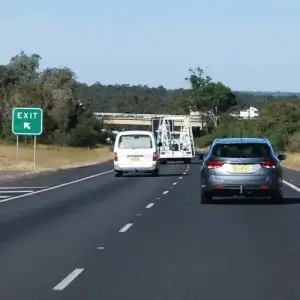Compare Comprehensive Car Insurance
A better way to get car insurance quotes









We do not compare all brands in the market or all products offered by all brands. At times certain brands or products may not be available or offered to you. Learn more about how our comparison service works.
Top 3 things to know about comprehensive car insurance
Higher level of cover
Comprehensive car insurance typically offers the most cover for repair and replacement costs for your vehicle.
How comprehensive cover is calculated
Your age, vehicle type and the amount you drive are just a few factors that will influence your comprehensive car insurance premiums.
A range of optional extras
A comprehensive policy can offer a range of optional extras such as accident hire car cover, roadside assistance and windscreen cover.
It pays to compare
Compare quotes in minutes and start saving today.
Simple to use
Get started by answering a few quick questions to help us understand your needs.
Compare & save
Save time and money by easily comparing options from a range of providers side-by-side.
Switching is easy
Follow a few easy steps online to switch to a new deal that suits you and your budget.

Why compare with us?
Our smart comparison technology is trusted, free, safe and secure.
Safe & secure
We take data privacy and security seriously, and will only use your information with your permission. You can read our full privacy policy here.

We believe the best decisions start with a comparison.
We’re proud to have helped millions of Aussies look for a better deal.


A guide to comprehensive car insurance
Updated 3 March 2025David Koch’s tips for saving on comprehensive car insurance
Find out how you could make comprehensive insurance more affordable.



Getting a new car is so exciting! But it’s also the worst possible time for a fender bender. Maybe you’re nervous to leave the garage. Well, that’s where insurance comes in.
And if you’ve made a significant investment in your new machine, you may want to consider comprehensive cover – that’s the highest level of cover available. It means you’re likely to have cover for damage to your own car, as well as any damage to another person’s vehicle or property, in the event of an accident. You could also be covered for damage from hail, fire and theft. And that’s just the more common comprehensive policy features.
It’s worthwhile checking the PDS for products before you buy to understand what you’re covered for and see if you could also have access to a range of optional extras like roadside assistance, car hire while you wait for repairs and new for old replacement. If you’re shopping around, Compare the Market has these tips to support your decision. First, consider the value of your vehicle. If you own a high-value car that would cost a significant amount to replace or repair, a comprehensive policy might be a good idea.
If you do want maximum cover, but still like to save, look at your excess. A higher excess could help you reduce your premium, though you’ll pay more if you have to make a claim. And when renewal time swings around, always check to see how the cost has changed. If your premium is up, it’s time to compare!
That’s where Compare the Market kicks into gear. You can look at a range of policies side-by-side and compare costs, benefits and inclusions all in one place. And the best part? It only takes a matter of minutes, so you can get back on the road sooner.
So fuel your savings journey today, with Compare the Market.
Expert tips on comprehensive car insurance
Our car insurance expert, Adrian Taylor, has some helpful tips for Australians with a comprehensive car insurance policy.

Adjust your excess
Adjusting your excess payment typically changes the premium you pay. Choosing a higher excess will lower your premium and is worth considering if you’re comfortable with paying more in the event of a claim.
Keep track of your discount
While online discounts can help you save on your policy, many insurers offer them for the first 12 months only. If yours is about to expire, consider comparing car insurance to make sure you’re still getting a great deal.
Check your new price at renewal
Look for your policy’s new price when your car insurance is up for renewal. All car insurance renewal notices must clearly state the difference in price compared to what you paid last year. It’s also a great time to compare and see if you can save on your cover.
The basics
What is comprehensive car insurance?
Comprehensive car insurance is a policy that provides the highest level of protection of the available types of cover in Australia. It generally covers damage to your own car, as well as other vehicles and third party property in motor vehicle accidents that are your fault. Comprehensive car insurance policies can also cover replacement costs if your vehicle is stolen.
Is comprehensive car insurance compulsory in Australia?
Comprehensive car insurance is not compulsory in Australia. The only mandatory cover for every vehicle in Australia is Compulsory Third Party (CTP) insurance or your state’s equivalent cover.
However, CTP won’t cover any vehicle or property damage. So, if CTP is the only cover you have, you’ll have to pay for these expenses if you’re at fault for a car accident.
Is comprehensive cover the best car insurance policy?
It depends on your needs as a motorist. If you’re looking for the most cover for your vehicle, a comprehensive car insurance policy could be suitable for you. It also generally offers the most optional extras to choose from, which you may include in your policy for an additional premium.
The following table is a guide of what each type of car insurance covers and excludes.
| Insurance type | Collision damage to own vehicle | Damage to another person’s car or property | Damage or loss caused by fire or theft | Injuries or death to other people in an accident |
|---|---|---|---|---|
| Comprehensive | ✓ | ✓ | ✓ | ✗ |
| Third Party Fire and Theft (TPFT) | ✗* | ✓ | ✓ | ✗ |
| Third Party Property Damage (TPPD) | ✗* | ✓ | ✗ | ✗ |
| CTP/ Green Slip | ✗ | ✗ | ✗ | ✓ |
| * Some insurers may cover your car if it’s damaged in a car accident by an uninsured driver. | ||||
What is the best comprehensive car insurance policy?
There’s no single best comprehensive car insurance policy for everyone. The most suitable for you will depend on various factors, including:
- Your location and financial situation
- Vehicle type, age and value
- Any optional extras you want.
Comprehensive policies can also differ depending on the insurer, which is why it’s important to shop around.
Inclusions and exclusions
What does comprehensive car insurance cover?
A comprehensive policy can cover the reasonable cost of vehicle repairs regardless of which party is responsible for the damage.
The table below is an overview of general inclusions and exclusions in comprehensive car insurance policies.
| Insured events | Typically covered? |
|---|---|
| Damage to your own vehicle following a collision | ✓ |
| Loss or damage to a third party’s vehicle/property caused by your car (legal liability) | ✓ |
| Loss or damage to your own vehicle caused by weather events (e.g. storm, flood, hail) | ✓ |
| Loss or damage to your vehicle caused by theft | ✓ |
| Hire car after theft | ✓ |
| New car replacement (if your car is less than two years old) | ✓ |
| Loss or damage to your vehicle caused by fire | ✓ |
| Loss or damage of personal possessions/effects | ✓ |
| Damage to your vehicle caused by an uninsured driver | ✓ |
| Emergency transport and/or accommodation | ✓ |
| Towing | ✓ |
| Key replacement | ✓ |
| Death benefit | ✓ |
| Legal liability for injuries or death to other people | ✗ |
| Variable excess | ✓ |
| Restricted driver discount | ✓ |
Always read the relevant Product Disclosure Statement (PDS) for full details on what insured events are covered and excluded, as well as other terms and conditions (T&Cs).
What does comprehensive car insurance not cover?
Typical exclusions in comprehensive car insurance policies are:
- Intentional damage to your vehicle
- Driving a car that isn’t roadworthy (e.g. defective brakes/lights, worn tyres)
- Damage caused by an unlicensed driver
- Damage caused when you’re under the influence of alcohol or drugs.
If you’re unsure about any specific details of your car insurance policy, check your PDS or contact your insurer.
Does comprehensive insurance cover me if I’m driving other cars?
A comprehensive car insurance policy insures your vehicle – not you. Any other vehicle you’re driving will need its own comprehensive car insurance policy.
Does comprehensive car insurance cover learner drivers?
Yes, comprehensive car insurance can cover learner drivers. Just keep in mind that if you’re supervising an L-plater, some insurers may ask you to list them as a driver of your car on your policy.
Policy features
What optional extras are available for a comprehensive policy?
Depending on your insurer, there could be a range of extras you could include in your policy for additional peace of mind. Some optional cover may include:
- Accident hire car provides a vehicle while yours is being fixed or replaced.
- Roadside assistance can help during car breakdowns, lockouts, flat tyres and – in some cases – emergency fuel.
- Windscreen excess waiver can save you from paying this excess when getting your window glass repaired or replaced.
- Choice of repairer allows you to select who repairs your car.
Do comprehensive car insurance policies offer a no claim bonus?
Your insurer may offer a no claim bonus or discount on your comprehensive car insurance if you don’t make a claim over a certain amount of time. Your no claims discount (NCD) generally increases every year you don’t claim, up until a maximum number of years (e.g. five years).
Can I choose to insure my car for an agreed value with comprehensive car insurance?
Some insurers provide the option for car owners to insure their car for an agreed value. So, if your car is written off, you’ll receive up to the agreed value minus any applicable excess payments.
Premiums, excesses and other costs
How much does comprehensive car insurance cost?
 The cost of your comprehensive car insurance policy will depend on several factors, including:
The cost of your comprehensive car insurance policy will depend on several factors, including:
- Age.Younger drivers tend to pay higher premiums, as they’re statistically more likely to be involved in road accidents than other age demographics.
- The amount you drive. Low kilometre drivers (e.g. retirees or public transport users) are less likely to make a claim than those who are always on the road. Driving your car for business purposes could also impact your premiums.
- Your driving and claims history. If you haven’t made a claim on your policy for a certain amount of time, you could qualify for an NCD.
- The vehicle you drive. Comprehensive insurance premiums vary depending on the year, make and model of car you drive.
- Where you park. Your address and postcode impact the cost of your premium. Insurance companies also consider if you park in a secure location or on the street.
- Your excess. Generally, the higher your excess payment, the lower your premium will be, and vice versa.
How can I get cheap comprehensive car insurance?
There could be several ways to get cheaper comprehensive car insurance in Australia, including:
- Getting an online discount for the first year of your cover
- Paying annual premiums instead of monthly instalments
- Parking your car in a garage instead of on the street
- Restricting the age of drivers on your policy (e.g. no one under 25)
- Only selecting the optional extras you need.
Opting for a higher policy excess is another way you could lower your premiums. However, before adjusting your excess, it’s worth considering if it’s an amount you can afford if you need to make a claim.
Is there an excess to pay when I claim on comprehensive car insurance?
 Your insurer may ask you to pay an excess when you claim on your comprehensive car insurance. Some common types of insurance excess are:
Your insurer may ask you to pay an excess when you claim on your comprehensive car insurance. Some common types of insurance excess are:
- Basic excess. An amount you may need to pay in the event of an at-fault or unrecoverable claim. This is the amount you select when you purchase your policy.
- Age/inexperienced driver excess. An additional excess that may apply when younger and less experienced drivers are responsible for the damage to the insured car.
- Undeclared or unlisted driver excess. This additional excess applies when the person claiming is not listed on your comprehensive car insurance policy.
Your insurer will advise you if an excess needs to be paid when you make a claim.
Can I choose the excess on my car insurance?
You can usually choose the basic excess amount for your policy, and it may have a direct impact on your premiums. A higher excess will generally result in lower premiums, and a lower excess could lead to higher premiums.
Managing your policy
How to make a comprehensive car insurance claim
You can usually make a claim on your comprehensive car insurance by contacting your insurer by phone or through their online portal. You may also submit a claim form via mail or email. It’s recommended to provide the following information to help your insurer process your claim:
- Contact details of other parties involved in the accident and witnesses
- Car insurance policy details from the other drivers
- Registration details of other vehicles involved
- Witness statements
- Photos and dash cam footage (if possible).
How to cancel your comprehensive policy
You can typically cancel your policy at any time by calling your insurer directly.
If you cancel within the cooling-off period, you may get a full refund on any premiums you’ve paid, as long as you haven’t made a claim. Otherwise, you may have to pay a cancellation fee if you cancel your policy outside of the cooling-off period.
You can find the full details of how to cancel your policy in the relevant PDS.
Compare comprehensive car insurance quotes online
Through our comparison service, you can get comprehensive car insurance quotes for your vehicle in just minutes. Along with selecting comprehensive from the different car insurance options, you’ll need to enter the following to get your quote:
- Basic car details like your vehicle’s make and model.
- Advanced car details such as if your vehicle has hail damage or modifications.
- Personal details including your name, date of birth and the age you got your licence.
Meet our car insurance expert, Adrian Taylor
As a General Insurance expert with over 13 years’ experience in financial services, Adrian Taylor is passionate about demystifying car insurance for consumers, so they have a better understanding of what they’re covered for. Adrian’s goal is to make more information available from more insurers, to make it easier to compare and save.

